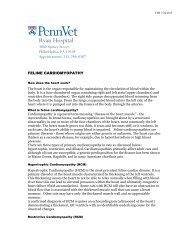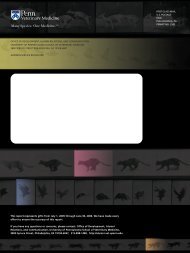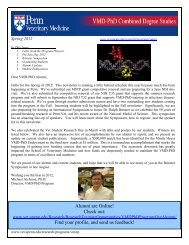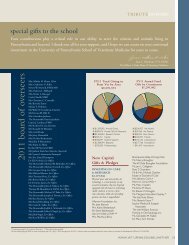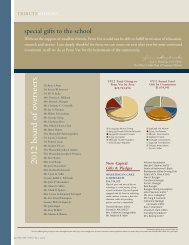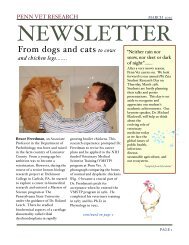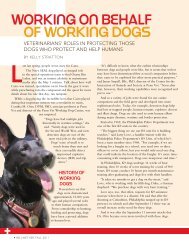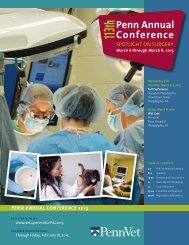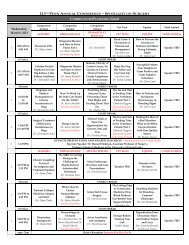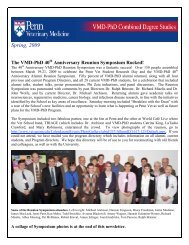Dec JAN Newsletter 2009-2010 - University of Pennsylvania School ...
Dec JAN Newsletter 2009-2010 - University of Pennsylvania School ...
Dec JAN Newsletter 2009-2010 - University of Pennsylvania School ...
You also want an ePaper? Increase the reach of your titles
YUMPU automatically turns print PDFs into web optimized ePapers that Google loves.
PENN VET RESEARCH DECEMBER <strong>2009</strong><br />
NEWSLETTER<br />
Squamous cell carcinoma is the most<br />
common oral cancer in humans and cats.....<br />
and the feline disease shares similarities with its human<br />
counterpart.<br />
Dr. John R. Lewis is an Assistant<br />
Pr<strong>of</strong>essor <strong>of</strong> Dentistry and Oral<br />
Surgery, Department <strong>of</strong> Clinical<br />
Studies PHL and Associate Director<br />
<strong>of</strong> Mari Lowe Center for Comparative<br />
Oncology. After obtaining his BS<br />
in biology from Bucknell <strong>University</strong><br />
in 1993 and his VMD from the<br />
<strong>University</strong> <strong>of</strong> <strong>Pennsylvania</strong> in 1997,<br />
Dr. Lewis signed on with a<br />
progressive small animal practice in<br />
Clayton, North Carolina. It was here<br />
where he first felt the frustration <strong>of</strong><br />
practitioners everywhere in dealing<br />
with feline oral squamous cell<br />
carcinoma (SCC). Although surgery<br />
Continued on page 4<br />
WHAT’S NEWSWORTHY IN EYE RE SEARCH<br />
As <strong>2009</strong> closes we can reflect on<br />
the many achievements <strong>of</strong> our<br />
faculty: publications highlighting<br />
our advances in basic, clinical and<br />
translational medicine, stimulus<br />
funds from NIH (> $4M), and an<br />
increase in overall grant funding<br />
from $30M in 2008 to $32M in<br />
<strong>2009</strong>. However, the challenges we<br />
face in the coming year will be<br />
substantial. Faculty funded by NIH<br />
will deal with significant changes in<br />
the format <strong>of</strong> grant applications and<br />
a reduction in the number <strong>of</strong><br />
resubmissions, and funding from all<br />
sources is likely to become more<br />
competitive. We can respond to<br />
these challenges by being proactive:<br />
writing grants earlier to obtain<br />
critical feedback from our<br />
colleagues prior to submission,<br />
highlighting our research strengths<br />
to expand our funding sources, and<br />
using the extensive resources in<br />
Penn’s biomedical community to<br />
employ the most innovative<br />
techniques in our research. Please<br />
contact me or Gayle Joseph to let us<br />
know how we can be <strong>of</strong> assistance in<br />
meeting these upcoming funding<br />
challenges.<br />
Phillip Scott<br />
On October 16, <strong>2009</strong>, András M. Komáromy Dr.Med.Vet., Ph.D., Assistant Pr<strong>of</strong>essor <strong>of</strong> Ophthalmology,<br />
Department <strong>of</strong> Clinical Studies Philadelphia and member <strong>of</strong> the Eye Research Group, joined the Association for<br />
Research in Vision and Ophthalmology (ARVO) board members and volunteers in Washington, DC to meet with<br />
members <strong>of</strong> Congress and their staffs and present them with vital information regarding vision research and its<br />
pr<strong>of</strong>ound effects on the millions <strong>of</strong> people who suffer from eye diseases. In an effort to educate legislators on the<br />
crucial need for continued funding <strong>of</strong> medical research, which has such significant results, ARVO members met with<br />
their respective representatives and made personal appeals for their support <strong>of</strong> such appropriations to make the case<br />
for translational vision research.<br />
PAGE 1
PENN VET RESEARCH DECEMBER <strong>2009</strong><br />
LESLIE KING--GRANTS EDITOR at Penn Vet<br />
Leslie King received her Ph.D.<br />
degree in Immunology and<br />
Microbiology from Duke <strong>University</strong><br />
and carried out her post-doctoral<br />
studies with Dr. Jonathan Ashwell at<br />
the National Cancer Institute,<br />
National Institutes <strong>of</strong> Health. She<br />
came to the <strong>University</strong> <strong>of</strong> <strong>Pennsylvania</strong><br />
<strong>School</strong> <strong>of</strong> Medicine (SoM) for a<br />
second post-doctoral fellowship in<br />
1996, working in the laboratory <strong>of</strong><br />
Dr. John Monroe, Department <strong>of</strong><br />
Pathology and Laboratory Medicine.<br />
While working with Dr. Monroe her<br />
research focused on the antigen<br />
receptor-induced signaling pathways<br />
involved in differential induction <strong>of</strong><br />
tolerance in immature lymphocytes<br />
and activation in more mature<br />
lymphoid populations. There she<br />
honed her grant writing skills and<br />
discovered she actually enjoyed the<br />
process! In 2007, Leslie joined Penn<br />
Vet as the first Grants Editor for the<br />
<strong>School</strong> and has been successfully<br />
working with principal investigators<br />
ever since.<br />
N I H A P P L I C AT I O N C H A N G E S F O R F Y 2 0 1 1 F U N D I N G<br />
Enhanced review criteria to<br />
be used by reviewers in their<br />
assessment <strong>of</strong> scientific and<br />
technical merit<br />
Biographical Sketch<br />
changes--a new personal<br />
statement will be<br />
incorporated. Limit the<br />
list <strong>of</strong> selected peerreviewed<br />
publications to<br />
no more than 15<br />
One additional page will be<br />
allowed for Specific Aims. For<br />
resubmission and revision<br />
applications for most<br />
programs, the introduction will<br />
be limited to one page<br />
IF YOU HAVE A COLLABORATOR providing a biosketch<br />
for your application...they must also follow the guidelines!<br />
For NIH detailed guidelines go to:<br />
http://grants.nih.gov/grants/guide/notice-files/NOT-OD-10-016.html<br />
When she is not editing grants, Leslie<br />
enjoys spending time with her husband<br />
Mickey Marks (SoM faculty member),<br />
her beautiful tweenage daughter<br />
Jennifer, and their two rescue pups,<br />
McKenzie and Beethoven.<br />
If you are interested in working with<br />
Dr. King on your next proposal, please<br />
contact Phil Scott via email at<br />
pscott@vet.upenn.edu. To discuss grant<br />
strategy, you may contact Dr. King<br />
directly at lbking@vet.upenn.edu . It is<br />
required that you provide a rough draft<br />
<strong>of</strong> your proposal 4 weeks prior to the<br />
deadline. Please note that Dr. King<br />
will also assist faculty with non-NIH<br />
grants and the importance <strong>of</strong> early<br />
drafts <strong>of</strong> your proposal applies here as<br />
well. Leslie King’s <strong>of</strong>fice is located at<br />
216 Rosenthal Building.<br />
Shortened page limits on<br />
NIH grants are announced<br />
for due dates on or after<br />
January 25, <strong>2010</strong><br />
Background and Significance, Preliminary<br />
Studies/Progress Report, and Research Design<br />
and Methods will be consolidated into a new<br />
single section called Research Strategy divided<br />
into 3 parts<br />
Resources section will be changed to<br />
require a description <strong>of</strong> how the scientific<br />
environment will contribute to the<br />
probability <strong>of</strong> success <strong>of</strong> the project<br />
PAGE 2
PENN VET RESEARCH DECEMBER <strong>2009</strong><br />
HISTOLOGY SERVICE AT PENN VET<br />
Dr.Goldschmidt established the biopsy<br />
service 34 years ago and it now ranks as<br />
the largest and most respected<br />
academic surgical biopsy service in the<br />
United States. Case material from this<br />
service has been used to train 43 board<br />
certified anatomic pathologists and this<br />
activity has resulted in scientific<br />
publications advancing clinical veteri-<br />
Dr. Elizabeth Mauldin<br />
Elizabeth Mauldin, DVM, is an<br />
Assistant Pr<strong>of</strong>essor (CE) <strong>of</strong> Pathology<br />
& Dermatology in the Department <strong>of</strong><br />
Pathobiology, <strong>University</strong> <strong>of</strong> <strong>Pennsylvania</strong><br />
<strong>School</strong> <strong>of</strong> Veterinary Medicine.<br />
She obtained her Doctor <strong>of</strong> Veterinary<br />
Medicine degree from North Carolina<br />
State <strong>University</strong> in 1993. As head <strong>of</strong><br />
Penn Vet’s histopathology laboratory,<br />
she directs the histology service<br />
at Penn Vet for both clinical and basic<br />
researchers. Dr. Mauldin is a veterinary<br />
dermatopathologist and works as<br />
both a pathologist, focused on skin<br />
biopsy interpretation, and a clinical<br />
dermatologist in the Matthew J. Ryan<br />
Hospital. The Penn Vet histology lab<br />
provides a range <strong>of</strong> services from<br />
tissue trimming, embedding and<br />
processing to histochemical staining<br />
which can be tailored to meet the<br />
needs <strong>of</strong> researchers. The lab has a<br />
busy surgical biopsy service, led<br />
by Dr. Michael Goldschmidt and<br />
supported by Drs. Amy Durham and<br />
Melissa Sanchez. The service is used<br />
by veterinary practices across the<br />
United States spanning Alaska to<br />
Puerto Rico.<br />
Histology Service Request forms are<br />
found at INSIDE.VET under ‘Research’<br />
http://inside-wlbs.vet.upenn.edu/<br />
Histopathology Laboratory 215 898-7874<br />
nary medicine. The case material from<br />
the surgical biopsy service also supports<br />
studies in the Veterinary Clinical<br />
Investigations Center and Oncology<br />
Service.<br />
Dr. Mauldin’s research interests focus<br />
on the recognition, pathogenesis and<br />
treatment <strong>of</strong> skin disorders in<br />
companion animals. Dr. Mauldin, in<br />
collaboration with Dr. Margret Casal<br />
from the Medical Genetics section, is<br />
investigating the pathogenesis <strong>of</strong> several<br />
hereditary canine skin diseases to<br />
increase understanding <strong>of</strong> the<br />
disorders, with the goal <strong>of</strong> ultimately<br />
developing a screening test to identify<br />
carrier animals. These include<br />
cutaneous exfoliative lupus<br />
erythematosus <strong>of</strong> the German shorthaired<br />
pointer, Ehlers Danlos disease<br />
and nonepidermolytic ichthyosis (fishscale<br />
disease) affecting the Golden<br />
retriever and American bulldog.<br />
Furthermore, extensive collaborative<br />
investigations are underway into the<br />
morphologic manifestations <strong>of</strong> canine<br />
X-linked hypohidrotic ectodermal<br />
dysplasia<br />
and<br />
response to<br />
interventionaltreatment<br />
as<br />
this disorder<br />
in<br />
dogs is<br />
identical to<br />
that seen in<br />
humans. A<br />
recent publication on X-linked<br />
Bronchial glands in XLHED treated and untreated dogs.<br />
Esophogeal glands in XHLED treated and untreated dogs<br />
Dr. Michael Goldschmidt<br />
ectodermal dysplasia treatment in dogs<br />
was showcased by the American Journal<br />
<strong>of</strong> Medical Genetics (September issue)<br />
(Vol 149A (9): 2045-2049 (<strong>2009</strong>).<br />
PAGE 3
PENN VET RESEARCH DECEMBER <strong>2009</strong><br />
continued from page 1<br />
can be curative in some cases, cats<br />
rarely show symptoms until the<br />
cancer has advanced to an inoperable<br />
size. In addition, oral SCC has<br />
historically been minimally responsive<br />
to radiation therapy and current<br />
chemotherapy options. Based on his<br />
interest in SCC, Dr. Lewis jumped at<br />
the chance to join a residency<br />
program at Penn Vet to further<br />
explore surgical and non-surgical<br />
options for improving the outcome<br />
for SCC patients.<br />
Treatment <strong>of</strong> oral SSC in feline<br />
patients- room for improvement<br />
SCC is the most common feline oral<br />
tumor, representing 70% <strong>of</strong> feline<br />
oral tumors. 1 As the median survival<br />
time from diagnosis to death or<br />
euthanasia is approximately 60 days 2 ,<br />
there is much room for improvement.<br />
While Dr. Lewis was eager to<br />
hone his surgical skills for treatment<br />
<strong>of</strong> feline SCC patients from<br />
established experts like Colin Harvey<br />
and Alexander Reiter at Penn Vet, he<br />
also saw an opportunity to improve<br />
treatment options for patients who<br />
were not surgical candidates. In<br />
conjunction with Dr. Tom O’Brien’s<br />
group at Lankenau Institute for<br />
Medical Research, Dr. Lewis and<br />
colleagues in Penn Vet’s Oncology<br />
Section and Dentistry and Oral<br />
Surgery Service embarked on a Phase<br />
I/II clinical trial <strong>of</strong> polyamine<br />
inhibitor therapy for cats with<br />
spontaneously occurring oral SSC.<br />
Dr. O’Brien, renowned for his work<br />
on the role <strong>of</strong> polyamines in cancer<br />
cell growth and successful polyaminebased<br />
therapy in experimentally<br />
induced murine models <strong>of</strong> SCC 3 , was<br />
anxious to evaluate this therapy in a<br />
spontaneous feline model, so the<br />
collaboration was initiated.<br />
Polyamine inhibitors<br />
Polyamines are ubiquitous amino acid<br />
derived compounds that have been<br />
widely implicated in the growth and<br />
development <strong>of</strong> many mammalian<br />
tissues. When cellular polyamine<br />
synthesis is inhibited, cell growth is<br />
stopped or severely retarded.<br />
Providing exogenous polyamines<br />
restores the growth <strong>of</strong> cells.<br />
Polyamine synthesis is increased in<br />
many types <strong>of</strong> cancers and expression<br />
levels <strong>of</strong> the rate limiting synthetic<br />
enzyme, ornithine decarboxylase<br />
(ODC), are <strong>of</strong>ten increased as well. 4<br />
As Dr. O’Brien’s original studies<br />
indicated that the ODC inhibitor<br />
difluoromethylornithine (DFMO) was<br />
effective in treating experimentally<br />
induced murine SCC 5 , a Phase I/II<br />
study was carried out to determine<br />
whether cats tolerate DFMO. Results<br />
<strong>of</strong> this study will soon be submitted<br />
for publication, but the relatively<br />
minimal side effects seen with DFMO<br />
protocols suggest that further studies<br />
are justified for use in a clinical<br />
setting.<br />
Although targeting polyamine<br />
synthesis with ODC inhibitors can be<br />
effective for cancer cell growth<br />
inhibition, most eukaryotic cells have<br />
a polyamine transport system in their<br />
cell membrane that facilitates<br />
internalization <strong>of</strong> extracellular<br />
polyamines. Thus, polyamine synthesis<br />
inhibitors will only fight half the<br />
battle in reducing intracellular<br />
polyamine levels. To overcome this<br />
limitation, Dr. Lewis’ latest study<br />
focuses on treating cats affected by<br />
oral SCC with a combination therapy<br />
utilizing DFMO and a polyamine<br />
transport inhibitor developed by MBF<br />
Therapeutics. The Veterinary Clinical<br />
Investigation Center (VCIC) has<br />
greatly facilitated all phases <strong>of</strong> this<br />
second combination study, and Dr.<br />
Lewis further credits the team effort<br />
put forth between Dr. Karin<br />
Sorenmo, Dr. Erika Krick, Dr. Nicola<br />
Mason, members <strong>of</strong> the Dentistry and<br />
Oral Surgery Service, Sections <strong>of</strong><br />
Radiology and Pathology, and practitioners<br />
who have shown interest in<br />
referring cases. While this study is still<br />
ongoing, it is the hope that such<br />
combined therapy will halt cancer<br />
growth but not significantly diminish<br />
other important quality <strong>of</strong> life aspects.<br />
Pets- man’s best friends provide<br />
hope for the future<br />
Feline oral SCC is a frustrating disease<br />
for pet owners, and there is an overt<br />
willingness <strong>of</strong> pet owners to help find<br />
better treatment options. Clients<br />
from near and far have inquired about<br />
ongoing SCC studies for treatment <strong>of</strong><br />
their cats. Indeed, one family from<br />
Chicago, the Dehertoghs, traveled to<br />
Penn for treatment <strong>of</strong> their cat, Tiger.<br />
Within a year, the Dehertoghs’ other<br />
cat, Elsa, developed oral SCC and was<br />
also enrolled in the study. Most<br />
notably, Ms. Kathleen Jack created the<br />
Feline Oral SCC Research Fund to<br />
support Dr. Lewis’ research when her<br />
cat, Bud, was diagnosed with the<br />
disease. While increased research on<br />
feline oral SCC will undoubtedly<br />
benefit feline patients, it is Dr. Lewis’<br />
hope that such research will also have<br />
important implications for human<br />
patients.<br />
Dr. Lewis’ belief that spontaneous<br />
companion animal cancer models<br />
continued on page 5<br />
PAGE 4
PENN VET RESEARCH DECEMBER <strong>2009</strong><br />
continued from page 4<br />
are invaluable for identifying and<br />
evaluating therapeutics for speciesspecific<br />
use as well as for eventual use<br />
in human patients led him to co-found<br />
the Comparative Oncology Working<br />
Group to further potential<br />
collaborations between veterinarians<br />
at Penn Vet and clinicians at the<br />
<strong>School</strong> <strong>of</strong> Medicine. He believes that<br />
such Spontaneous Parallel Reciprocal<br />
Models (SPAREDELs), a term<br />
coined by a member <strong>of</strong> Penn’s<br />
Comparative Oncology Working<br />
Group and recently discussed in<br />
JAVMA6 TIGER<br />
, are extremely valuable to<br />
researchers attempting to span the<br />
gap from bench to bedside. Indeed,<br />
spontaneous companion animal<br />
models <strong>of</strong>ten more closely resemble<br />
human disease conditions than do<br />
experimentally induced rodent<br />
models. In addition, since pets and<br />
people are exposed to common<br />
environmental influences that could<br />
predispose to disease, these models<br />
provide a unique opportunity for<br />
obtaining insight into the comparable<br />
human cancers. As many clinicians are<br />
unaware <strong>of</strong> currently existing<br />
spontaneous animal models in their<br />
research area, Dr. Lewis is dedicated<br />
to increasing awareness <strong>of</strong> the<br />
importance <strong>of</strong> comparative analysis <strong>of</strong><br />
spontaneous diseases in companion<br />
animals and humans for the mutual<br />
benefit <strong>of</strong> all species. Dr. Lewis’<br />
research is funded by the Squamous<br />
Cell Carcinoma Research Fund<br />
(created by a donation from Ms.<br />
Kathleen Jack), and subcontracting<br />
through projects funded at Lankenau<br />
Institute for Medical Research.<br />
Dr. Lewis’ <strong>of</strong>fice is in Ryan, room<br />
3109.<br />
References<br />
1. Lewis JR. Oral neoplasiamalignant.<br />
In: Cote, E, ed. Clinical<br />
Veterinary Advisor. Philadelphia: Mosby<br />
Elsevier, 2007; 771-773.<br />
2. Reeves NCP, Turrel JM, Withrow<br />
SJ. Oral squamous cell carcinoma in<br />
the cat. J Am Anim Hosp Assoc 1993,<br />
29: 438-441.<br />
3. Chen Y, Hu J, Boorman D, Klein-<br />
Szanto A, and O’Brien TG, Therapy <strong>of</strong><br />
murine squamous cell carcinomas<br />
with 2-diflouromethylornithine. J<br />
Carcinogenesis 2004, 3: 1-10.<br />
4. Duda L, Lewis JR, Kagan SH,<br />
Evans SM. Letter to the editor:<br />
SPAREDEL-Spontaneous parallel<br />
reciprocal model. JAVMA <strong>2009</strong>, 235<br />
(8): 933.<br />
Secretary <strong>of</strong> Agriculture launches<br />
National Institute <strong>of</strong> Food and<br />
Agriculture: science and research<br />
at USDA—Agricultural Science<br />
poised to make major contributions<br />
to health, environmental challenges<br />
In October <strong>2009</strong> Agriculture Secretary Tom<br />
Vilsack announced the National Institute <strong>of</strong><br />
Food and Agriculture (NIFA). He outlined<br />
his vision for global challenges we face over<br />
the next decades. Secretary Vilsack sees a<br />
need for the USDA science to focus its<br />
resources on accomplishing a few, bold<br />
outcomes to improve human health and<br />
protect our environment.<br />
•Keep American agriculture competitive<br />
and end world hunger<br />
•Improve nutrition and end child obesity<br />
•USDA science will support efforts to<br />
improve food safety—studies on the impact<br />
<strong>of</strong> food-borne diseases<br />
•USDA science will secure American’s<br />
energy—by rapidly improving the quality<br />
<strong>of</strong> plant-based feed-stocks that will be a<br />
source <strong>of</strong> bi<strong>of</strong>uel<br />
•Animal agriculture research will strive for<br />
positive contributions to environmental,<br />
human, and animal health<br />
•USDA science to make us better stewards<br />
<strong>of</strong> the environment and identify agricultural<br />
operations that will be net carbon sinks<br />
In launching a new paradigm for the science<br />
that underpins our food, agriculture, and<br />
natural resources systems research, a new<br />
promise for <strong>School</strong>s <strong>of</strong> Veterinary Medicine<br />
comes into view. Visit:http://<br />
www.nifa.usda.gov/ and search NIFA.<br />
Figure 1: Oral squamous cell carcinoma is the most common oral cancer in humans and<br />
cats. (Human photo courtesy <strong>of</strong> The Merck Manual Online Medical Library).<br />
PAGE 5
PENN VET RESEARCH DECEMBER <strong>2009</strong><br />
PENN VET’S<br />
NEUROSCIENCE CENTER<br />
Neuroscience research at Penn Vet<br />
focuses on clinical and basic studies to<br />
improve our understanding <strong>of</strong> the central<br />
nervous system and its involvement in<br />
diseases ranging from neurodegenerative<br />
disorders to obesity. Core areas <strong>of</strong><br />
emphasis and expertise include feeding<br />
behavior/metabolism (Tracy Bale,<br />
Kendra Bence, Narayan Avadhani,<br />
and Dan Yee labs), sleep (Leszek<br />
Kubin lab), stress and neuro-psychiatric<br />
diseases (Tracy Bale, Adrian<br />
Morrison labs), neuro-transmission<br />
(Tom Parsons lab) and neuroimmunology<br />
(Chris Hunter lab). In<br />
these studies, the generation <strong>of</strong><br />
important animal models <strong>of</strong> disease<br />
provides valuable information that aids in<br />
the development <strong>of</strong> new drug targets and<br />
therapies in disease prevention and<br />
treatment. As one <strong>of</strong> the key focuses<br />
within Penn Vet research, the neuroscience<br />
<strong>of</strong> obesity focuses on understanding<br />
the underlying causes <strong>of</strong> the<br />
recent escalation in overweight and obese<br />
humans and domestic pets. Basic research<br />
is examining the signal transduction<br />
pathways involved in regulation <strong>of</strong><br />
feeding behavior (Bence lab) and the<br />
neuroplasticity and stress related to<br />
dietary changes that may promote longterm<br />
weight gain (Bale lab). The goal <strong>of</strong><br />
the clinical neuroscience research at Penn<br />
Vet is to improve the characterization and<br />
treatment <strong>of</strong> nervous system disease in<br />
animal patients. Studies focus on<br />
naturally occurring neurodegenerative<br />
diseases in dogs and cats including<br />
lysosomal storage diseases (Niemann-<br />
Pick type C, alpha-mannosidosis, globoid<br />
cell leuko-dystrophy, and mucopolysaccharidososes)<br />
(Charles Vite lab).<br />
Current treatment emphasis is centered<br />
on the development <strong>of</strong> therapies for these<br />
diseases using pharmaceuticals and gene<br />
transfer technologies.<br />
This spring, the Neuroscience Center<br />
will co-host two invited speakers in<br />
areas <strong>of</strong> expertise and interest in<br />
concert with the <strong>School</strong> <strong>of</strong> Medicine<br />
(SOM). The first seminar is the Vice<br />
Provost Special Seminar in<br />
Neuroscience co-sponsored by Penn’s<br />
Mahoney Institute <strong>of</strong> Neurological<br />
Sciences, Genetics, and the Intellectual<br />
and Developmental Disabilities<br />
Research Center. Eric Nestler,<br />
Ph.D., pr<strong>of</strong>essor and chair <strong>of</strong><br />
Neuroscience at Mt. Sinai <strong>School</strong> <strong>of</strong><br />
Medicine, will be the speaker on March<br />
22, <strong>2010</strong> in the BRB auditorium. Dr.<br />
Nestler’s research crosses many areas<br />
and levels <strong>of</strong> neuroscience including the<br />
neurobiology <strong>of</strong> addiction and affective<br />
disorders and epigenetics. The second<br />
joint seminar will be the Neuroscience<br />
<strong>of</strong> Obesity Special Seminar with the<br />
SOM Institute for Diabetes, Obesity and<br />
Metabolism on May 11, <strong>2010</strong> in Hill<br />
Pavilion, Room 130. The speaker will be<br />
Martin Myers Jr, M.D., Ph.D., from<br />
the <strong>University</strong> <strong>of</strong> Michigan. Dr. Myers’<br />
research focuses on the molecular<br />
mechanisms contributing to obesity and<br />
diabetes. There will be a catered<br />
reception following both seminars.<br />
More details including seminar titles<br />
will be available in early <strong>2010</strong>.<br />
Tracy L. Bale, Ph.D., Director<br />
Recent Awards<br />
Mark A. Oyama, DVM and Associate<br />
Pr<strong>of</strong>essor in the Department <strong>of</strong> Clinical<br />
Studies - Philadelphia, received the<br />
Cardiology American Kennel Club-Canine<br />
Health Foundation Asa Mays, DVM,<br />
Excellence in Canine Health Research<br />
Award at the National Parent Club Canine<br />
Health Conference in St. Louis, MO.<br />
F. Claire Hankenson, DVM, Assistant<br />
Pr<strong>of</strong>essor in Pathobiology, and Senior<br />
Associate Director in <strong>University</strong> Laboratory<br />
Animal Resources, was the recipient<br />
<strong>of</strong> the <strong>2009</strong> Pravin N. Bhatt Young Investigator<br />
Award from the the American<br />
Association for Laboratory Animal Science<br />
recognizing outstanding young scientist<br />
who has made significant contributions to<br />
the fields <strong>of</strong> laboratory animal science or<br />
comparative medicine.<br />
Recent Publications<br />
Neonatal treatment with recombinant<br />
ectodysplasin prevents respiratory disease<br />
in dogs with Xlinked<br />
ectodermal<br />
dysplasia. (<strong>2009</strong>)<br />
Mauldin EA,<br />
Gaide O,<br />
Schneider P,<br />
Casal ML. Am.<br />
J. Med. Genet. 149A(9): 2045-9.<br />
Regulation <strong>of</strong><br />
inflammatory responses<br />
by gut microbiota and<br />
chemoattractant<br />
receptor GPR43.<br />
Maslowski KM, Vieira<br />
AT, Ng A, Kranich J,<br />
Sierro F, Yu D, Schilter<br />
HC, Rolp, MS, Mackay<br />
F, Artis, D., Xavier<br />
RJ, Teixeira MM, &<br />
Mackay CR. (<strong>2009</strong>)<br />
Nature 461:1282-6.<br />
Interaction Between<br />
Ebola Virus Glycoprotein<br />
and Host TLR-4<br />
Leads to Induction <strong>of</strong><br />
Pro-Inflammatory<br />
Cytokines and<br />
SOCS1.Okumura A,<br />
Pitha PM, Yoshimura A,<br />
Harty RN. J Virol. <strong>2009</strong> Oct 21. [Epub<br />
ahead <strong>of</strong> print]<br />
PAGE 6
PENN VET RESEARCH DECEMBER <strong>2009</strong><br />
New policies for Public Access--you have to play to get paid!!<br />
Are you in compliance with the<br />
NIH Public Access Policy (http://<br />
publicaccess.nih.gov/)? Your award<br />
money is dependent on it!! The<br />
policy requires NIH-funded<br />
investigators to 1) submit final peerreviewed<br />
manuscripts to PubMed<br />
Central (PMC) and 2) to cite NIHfunded<br />
research using the PMCsupplied<br />
reference number (PMCID)<br />
in all NIH applications and progress<br />
reports. As many investigators are<br />
failing to complete the submission<br />
process, the NIH is now requiring<br />
PMCID numbers within 3 months<br />
<strong>of</strong> publication (http://<br />
grants.nih.gov/grants/guide/noticefiles/NOT-OD-09-136.html).<br />
Program<br />
<strong>of</strong>ficer are monitoring awards; as<br />
non-compliance can result in<br />
withholding <strong>of</strong> funds, submit<br />
your manuscripts to PMC upon<br />
final acceptance for publication<br />
don’t wait until applications/<br />
progress reports are due!<br />
How do I submit my accepted<br />
manuscript to PMC? Before<br />
signing any publication and/or<br />
copyright transfer agreement, make<br />
sure that it allows the paper to be<br />
posted to PMC. If not, check with<br />
your institutional <strong>of</strong>ficial and/or legal<br />
counsel to ensure compliance. If the<br />
journal is not submitting the<br />
published article to PMC on your<br />
behalf, you must submit the final<br />
peer-reviewed manuscript<br />
(including all suggested<br />
modifications, figure and table files,<br />
and supplementary materials) to the<br />
NIH Manuscript Submissions<br />
(NIHMS). Complete instructions can<br />
be obtained at http://<br />
publicaccess.nih.gov/<br />
submit_process.htm and FAQs are at:<br />
http://www.nihms.nih.gov/faq.html.<br />
Following submission, you will<br />
receive an NIHMSID that can be used<br />
as a temporary measure to cite<br />
papers within 3 months <strong>of</strong><br />
publication. The NIHMS will email<br />
the author for approval <strong>of</strong> the<br />
converted files and a PMCID will be<br />
provided following final approval.<br />
How do I cite public access<br />
articles? When citing a paper in<br />
NIH applications and progress<br />
reports, you must include either the<br />
NIHMSID (within 3 months <strong>of</strong><br />
publication) or the PMCID. Such<br />
citations should be included in your<br />
Bibliography, Progress Report, and<br />
Biosketch. For further directions, see<br />
http://grants.nih.gov/grants/guide/<br />
notice-files/NOT-OD-08-119.html.<br />
Check your eRA Commons pr<strong>of</strong>ile<br />
regularly to see which manuscripts<br />
are linked with your award in the<br />
NIHMS.<br />
What do I do if I’m not<br />
compliant? First, determine if your<br />
manuscripts HAVE an assigned<br />
PMCID. The PMCID is a 7 digit<br />
number preceded by PMC located<br />
under the right hand side <strong>of</strong> a Pub-<br />
Med abstract. If your manuscripts do<br />
NOT have a PMCID, submit the final<br />
version <strong>of</strong> the manuscript to NIHMS<br />
(see above) after making sure that<br />
copyright transfer agreement allow<br />
you to do so. Be aware that if a paper<br />
is 3 months beyond publi-cation, an<br />
NIHMSID will NOT be issued. As a<br />
PMCID is required for compliance<br />
and will not be issued for several<br />
weeks, submit your manu-scripts<br />
NOW before your applications/<br />
progress reports are due!!<br />
Some recent awards....<br />
Gary Smith, D.Phil, Model Hierarchies<br />
Working Group within RAPIDD Program--<br />
Fogarty International CTR/NIH. 7/1/<strong>2009</strong> -<br />
6/30/2011 $93,060<br />
Brett Kaufman, Ph.D., Identification and<br />
characterization <strong>of</strong> genes affecting mitochondrial<br />
myopathies, Muscular Dystrophy<br />
Assoc. 1/1/09 --12/1/<strong>2010</strong>, $81,800<br />
Brett Kaufman, Ph.D., The contribution <strong>of</strong><br />
mitochondrial DNA organization to the<br />
mitochondrial dysfunction induced by high<br />
glucose levels in cancer. Pilot grant from Mari<br />
Lowe Center for Comparitive Oncology<br />
5/01/09-04/31/<strong>2010</strong>, $20,000<br />
Gustavo Aguirre, VMD. PhD, NIH<br />
Supplement to Translational Research for Retinal<br />
Degeneration Therapies, $140,375.<br />
Dorothy Brown, DVM, MSCE,<br />
Development <strong>of</strong> a canine Model <strong>of</strong> Radiotherapy<br />
Induced Oral Mucositis. NIH<br />
9/25/09-8/31/11, $275,000<br />
Chris Hunter, Ph.D. "What is the effect <strong>of</strong><br />
IL-27 on Treg expansion and homeostasis?"<br />
Centocor, 8/3/09-8/2/10, $100,000.<br />
Chris Hunter, Ph.D. Molecular & Cellular<br />
Regulation <strong>of</strong> Tolerance, project in a NIH<br />
program project grant, 7/22/09 - 6/30/2011,<br />
$501,676<br />
Chris Hunter, Ph.D., Supplement to Immunopathogenesis<br />
<strong>of</strong> toxoplasmic encephalitis,<br />
9/22/09 - 9/21/2011, NIH, $130,582.<br />
Michael Atchison, PhD, NIH Supplement to<br />
PcG Function <strong>of</strong> YY1 in Transcription and<br />
Development. $71,509<br />
PAGE 7
PENN VET RESEARCH DECEMBER <strong>2009</strong><br />
Coins for Canine Cancer Research<br />
Phillip Scott, Associate Dean for Research<br />
receives a gift <strong>of</strong> a piggy bank from Dr.<br />
Chris Anastasiou <strong>of</strong> Modern Eye optical<br />
shop in <strong>University</strong> City in support <strong>of</strong><br />
canine cancer research.<br />
<strong>University</strong> <strong>of</strong> <strong>Pennsylvania</strong> <strong>School</strong> <strong>of</strong> Veterinary Medicine<br />
380 S <strong>University</strong> Avenue, Suite 310B HIll Pavilion<br />
Philadelphia PA 19104-4539<br />
Art by Nancy Norman<br />
Dr. Christopher Anastasiou,<br />
Optometrist <strong>of</strong> the Modern Eye,<br />
located at 3419 Walnut Street at the<br />
Shops at Penn in <strong>University</strong> City, has<br />
been collecting donations in a blue<br />
piggy bank at his <strong>of</strong>fice in memory <strong>of</strong><br />
his two dogs, Lucky and Buddy, who<br />
were treated at the Matthew J Ryan<br />
Veterinary Hospital <strong>of</strong> the <strong>University</strong> <strong>of</strong><br />
<strong>Pennsylvania</strong> <strong>School</strong> <strong>of</strong> Veterinary<br />
Medicine. He recently presented the<br />
piggy bank tightly packed with<br />
$1289.58 in coins and dollar bills. In<br />
addition, Dr. Anastasiou graciously<br />
presented Penn Vet with a check for<br />
$1000 and he has a new piggy bank set<br />
up and ready to continue collecting for<br />
the Lucky & Buddy Fund for Canine<br />
Cancer Research. Stop in and see him.<br />
TO:<br />
All rights reserved. No part <strong>of</strong> this publication may be reproduced without permission<br />
The Penn Vet Research <strong>Newsletter</strong><br />
will be distributed quarterly.<br />
Suggestions, requests, comments, and<br />
story ideas should be directed to:<br />
resnews@vet.upenn.edu.<br />
Office <strong>of</strong> the Associate Dean<br />
for Research<br />
Phillip Scott, Ph.D.



